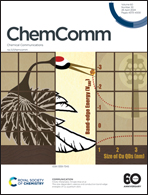Molecular recognition and proteoglycan mimic arrangement: modulating cisplatin toxicity†
Abstract
We have demonstrated that cisplatin (CP), an anticancer drug, showed a preference for binding the sulfated-L-iduronic acid (S-L-IdoA) unit over the sulfated-D-glucuronic acid unit of heparan sulfate. The multivalency of S-L-IdoA, such as in the proteoglycan mimic, resulted in distinct modes of cell-surface engineering in normal and cancer cells, with these disparities having a significant impact on CP-mediated toxicity.



 Please wait while we load your content...
Please wait while we load your content...